Analysis of the Business Environment for British Airways
VerifiedAdded on 2019/12/28
|13
|4290
|195
Report
AI Summary
This report provides a comprehensive analysis of the business environment surrounding British Airways (BA). It begins by examining the different types of organizations and their purposes, then delves into the stakeholders of BA, including customers, suppliers, employees, government, and investors, detailing their objectives and how BA meets them. The report further explores BA's responsibilities towards these stakeholders and the strategies employed to fulfill them. It then analyzes the role of economic systems in resource allocation, focusing on mixed economies and their impact on BA. The study also assesses the influence of fiscal and monetary policies, as well as competition policies and regulatory mechanisms, on BA's activities. Furthermore, it examines how market structures determine pricing and output decisions, illustrating how market forces shape organizational responses and how business and cultural environments influence BA's behavior. Finally, the report discusses the significance of international trade, global factors, and the impact of European Union policies on UK business organizations like BA.
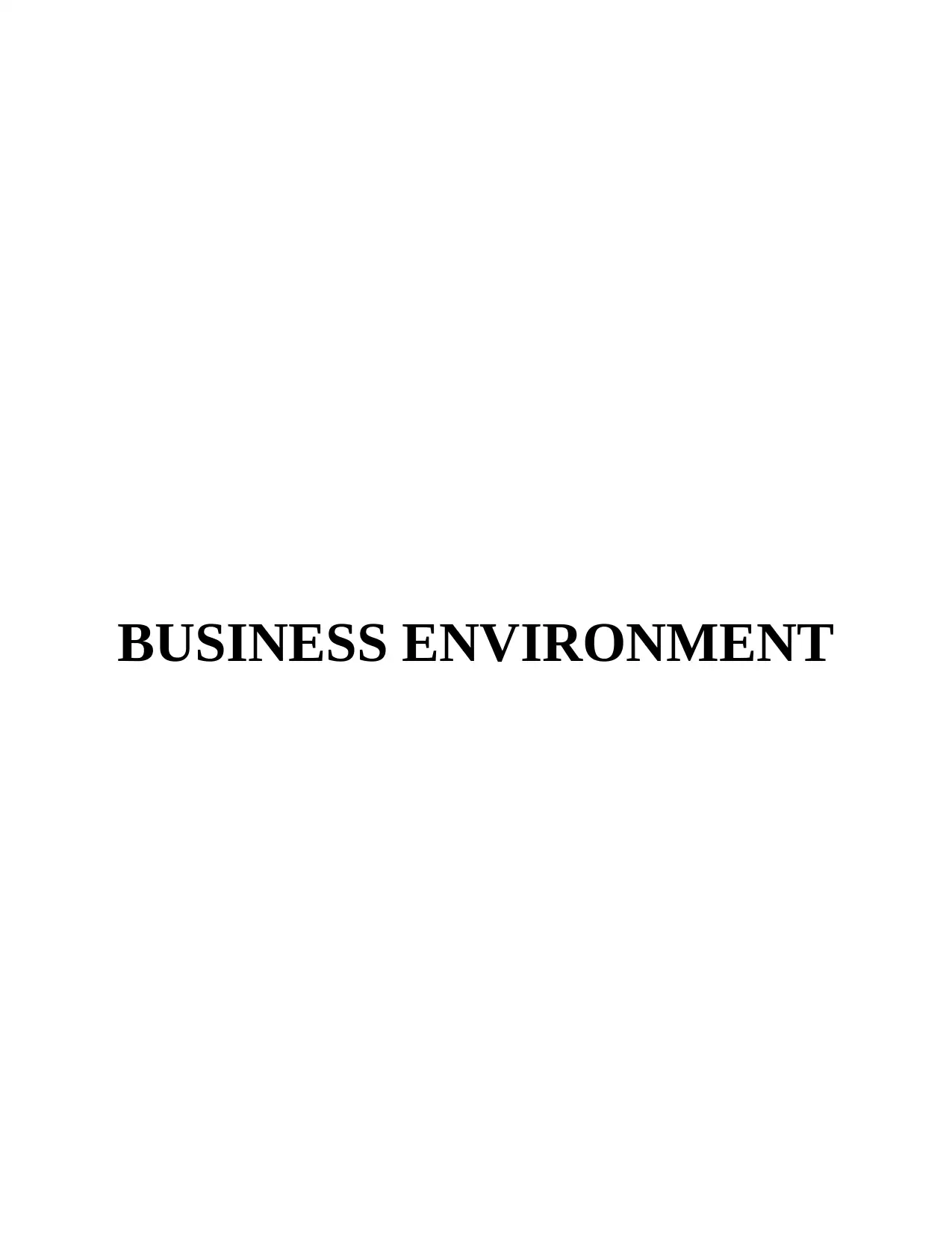
BUSINESS ENVIRONMENT
Paraphrase This Document
Need a fresh take? Get an instant paraphrase of this document with our AI Paraphraser
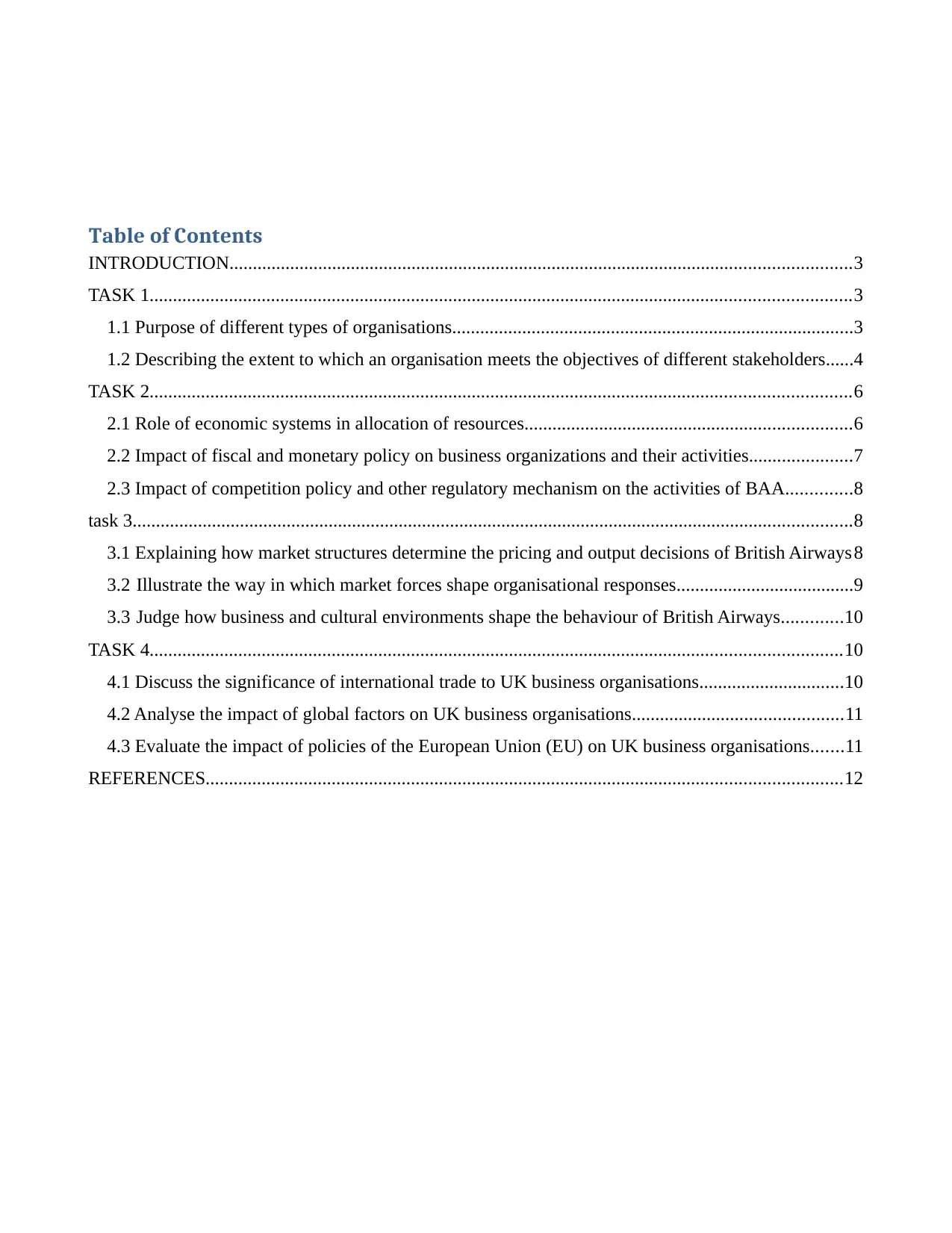
Table of Contents
INTRODUCTION.....................................................................................................................................3
TASK 1......................................................................................................................................................3
1.1 Purpose of different types of organisations......................................................................................3
1.2 Describing the extent to which an organisation meets the objectives of different stakeholders......4
TASK 2......................................................................................................................................................6
2.1 Role of economic systems in allocation of resources......................................................................6
2.2 Impact of fiscal and monetary policy on business organizations and their activities......................7
2.3 Impact of competition policy and other regulatory mechanism on the activities of BAA..............8
task 3..........................................................................................................................................................8
3.1 Explaining how market structures determine the pricing and output decisions of British Airways8
3.2 Illustrate the way in which market forces shape organisational responses......................................9
3.3 Judge how business and cultural environments shape the behaviour of British Airways.............10
TASK 4....................................................................................................................................................10
4.1 Discuss the significance of international trade to UK business organisations...............................10
4.2 Analyse the impact of global factors on UK business organisations.............................................11
4.3 Evaluate the impact of policies of the European Union (EU) on UK business organisations.......11
REFERENCES........................................................................................................................................12
INTRODUCTION.....................................................................................................................................3
TASK 1......................................................................................................................................................3
1.1 Purpose of different types of organisations......................................................................................3
1.2 Describing the extent to which an organisation meets the objectives of different stakeholders......4
TASK 2......................................................................................................................................................6
2.1 Role of economic systems in allocation of resources......................................................................6
2.2 Impact of fiscal and monetary policy on business organizations and their activities......................7
2.3 Impact of competition policy and other regulatory mechanism on the activities of BAA..............8
task 3..........................................................................................................................................................8
3.1 Explaining how market structures determine the pricing and output decisions of British Airways8
3.2 Illustrate the way in which market forces shape organisational responses......................................9
3.3 Judge how business and cultural environments shape the behaviour of British Airways.............10
TASK 4....................................................................................................................................................10
4.1 Discuss the significance of international trade to UK business organisations...............................10
4.2 Analyse the impact of global factors on UK business organisations.............................................11
4.3 Evaluate the impact of policies of the European Union (EU) on UK business organisations.......11
REFERENCES........................................................................................................................................12
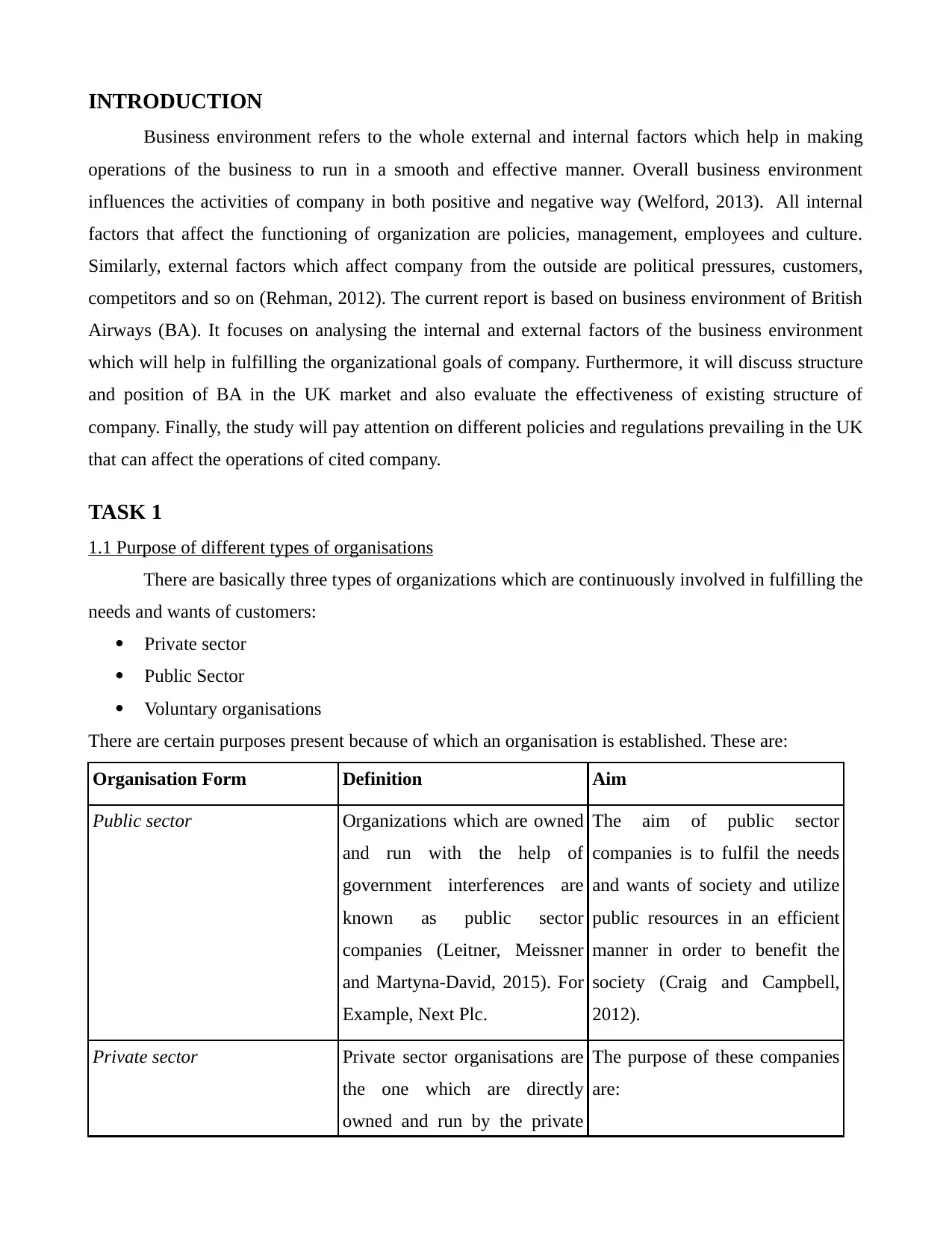
INTRODUCTION
Business environment refers to the whole external and internal factors which help in making
operations of the business to run in a smooth and effective manner. Overall business environment
influences the activities of company in both positive and negative way (Welford, 2013). All internal
factors that affect the functioning of organization are policies, management, employees and culture.
Similarly, external factors which affect company from the outside are political pressures, customers,
competitors and so on (Rehman, 2012). The current report is based on business environment of British
Airways (BA). It focuses on analysing the internal and external factors of the business environment
which will help in fulfilling the organizational goals of company. Furthermore, it will discuss structure
and position of BA in the UK market and also evaluate the effectiveness of existing structure of
company. Finally, the study will pay attention on different policies and regulations prevailing in the UK
that can affect the operations of cited company.
TASK 1
1.1 Purpose of different types of organisations
There are basically three types of organizations which are continuously involved in fulfilling the
needs and wants of customers:
Private sector
Public Sector
Voluntary organisations
There are certain purposes present because of which an organisation is established. These are:
Organisation Form Definition Aim
Public sector Organizations which are owned
and run with the help of
government interferences are
known as public sector
companies (Leitner, Meissner
and Martyna-David, 2015). For
Example, Next Plc.
The aim of public sector
companies is to fulfil the needs
and wants of society and utilize
public resources in an efficient
manner in order to benefit the
society (Craig and Campbell,
2012).
Private sector Private sector organisations are
the one which are directly
owned and run by the private
The purpose of these companies
are:
Business environment refers to the whole external and internal factors which help in making
operations of the business to run in a smooth and effective manner. Overall business environment
influences the activities of company in both positive and negative way (Welford, 2013). All internal
factors that affect the functioning of organization are policies, management, employees and culture.
Similarly, external factors which affect company from the outside are political pressures, customers,
competitors and so on (Rehman, 2012). The current report is based on business environment of British
Airways (BA). It focuses on analysing the internal and external factors of the business environment
which will help in fulfilling the organizational goals of company. Furthermore, it will discuss structure
and position of BA in the UK market and also evaluate the effectiveness of existing structure of
company. Finally, the study will pay attention on different policies and regulations prevailing in the UK
that can affect the operations of cited company.
TASK 1
1.1 Purpose of different types of organisations
There are basically three types of organizations which are continuously involved in fulfilling the
needs and wants of customers:
Private sector
Public Sector
Voluntary organisations
There are certain purposes present because of which an organisation is established. These are:
Organisation Form Definition Aim
Public sector Organizations which are owned
and run with the help of
government interferences are
known as public sector
companies (Leitner, Meissner
and Martyna-David, 2015). For
Example, Next Plc.
The aim of public sector
companies is to fulfil the needs
and wants of society and utilize
public resources in an efficient
manner in order to benefit the
society (Craig and Campbell,
2012).
Private sector Private sector organisations are
the one which are directly
owned and run by the private
The purpose of these companies
are:
⊘ This is a preview!⊘
Do you want full access?
Subscribe today to unlock all pages.

Trusted by 1+ million students worldwide
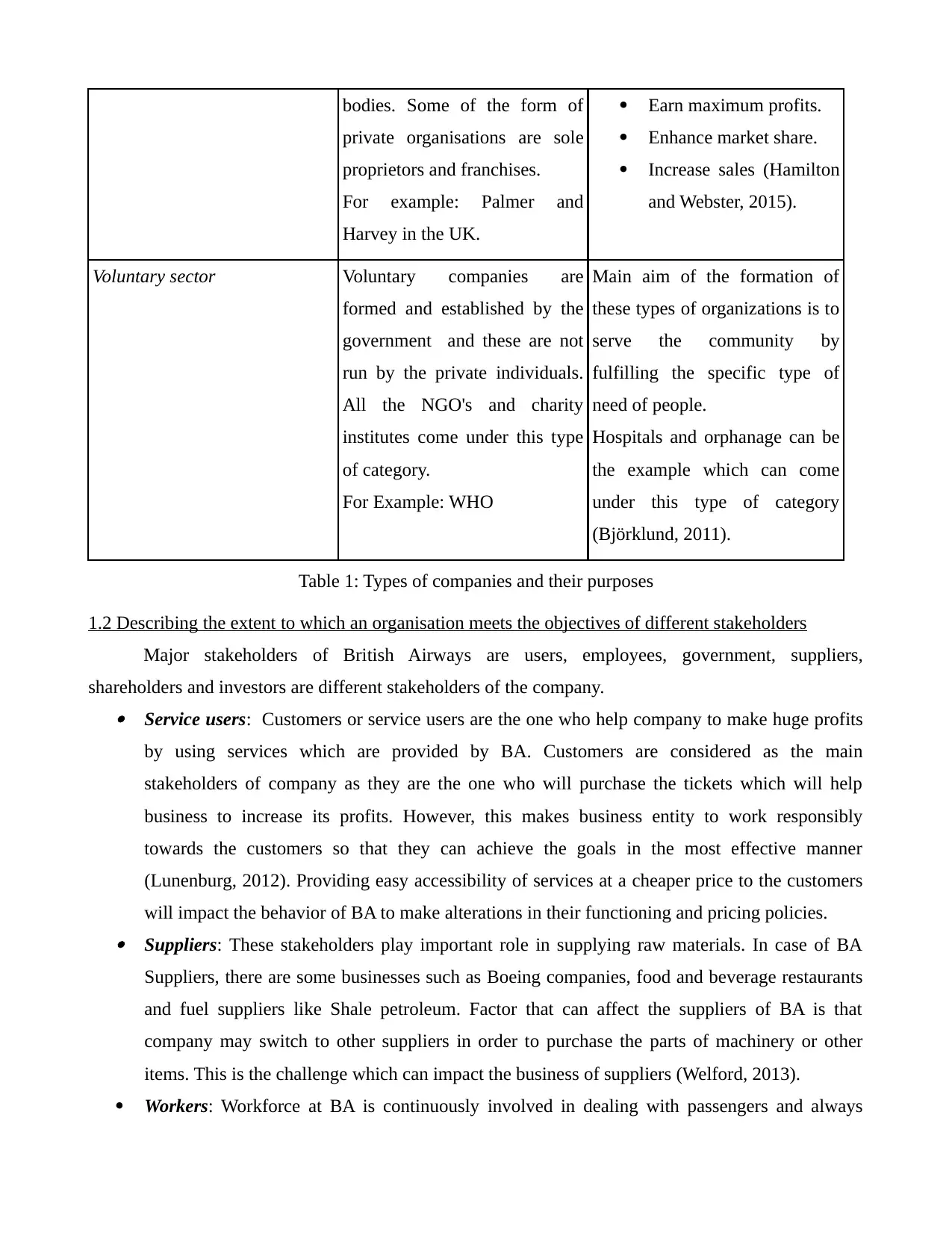
bodies. Some of the form of
private organisations are sole
proprietors and franchises.
For example: Palmer and
Harvey in the UK.
Earn maximum profits.
Enhance market share.
Increase sales (Hamilton
and Webster, 2015).
Voluntary sector Voluntary companies are
formed and established by the
government and these are not
run by the private individuals.
All the NGO's and charity
institutes come under this type
of category.
For Example: WHO
Main aim of the formation of
these types of organizations is to
serve the community by
fulfilling the specific type of
need of people.
Hospitals and orphanage can be
the example which can come
under this type of category
(Björklund, 2011).
Table 1: Types of companies and their purposes
1.2 Describing the extent to which an organisation meets the objectives of different stakeholders
Major stakeholders of British Airways are users, employees, government, suppliers,
shareholders and investors are different stakeholders of the company. Service users: Customers or service users are the one who help company to make huge profits
by using services which are provided by BA. Customers are considered as the main
stakeholders of company as they are the one who will purchase the tickets which will help
business to increase its profits. However, this makes business entity to work responsibly
towards the customers so that they can achieve the goals in the most effective manner
(Lunenburg, 2012). Providing easy accessibility of services at a cheaper price to the customers
will impact the behavior of BA to make alterations in their functioning and pricing policies. Suppliers: These stakeholders play important role in supplying raw materials. In case of BA
Suppliers, there are some businesses such as Boeing companies, food and beverage restaurants
and fuel suppliers like Shale petroleum. Factor that can affect the suppliers of BA is that
company may switch to other suppliers in order to purchase the parts of machinery or other
items. This is the challenge which can impact the business of suppliers (Welford, 2013).
Workers: Workforce at BA is continuously involved in dealing with passengers and always
private organisations are sole
proprietors and franchises.
For example: Palmer and
Harvey in the UK.
Earn maximum profits.
Enhance market share.
Increase sales (Hamilton
and Webster, 2015).
Voluntary sector Voluntary companies are
formed and established by the
government and these are not
run by the private individuals.
All the NGO's and charity
institutes come under this type
of category.
For Example: WHO
Main aim of the formation of
these types of organizations is to
serve the community by
fulfilling the specific type of
need of people.
Hospitals and orphanage can be
the example which can come
under this type of category
(Björklund, 2011).
Table 1: Types of companies and their purposes
1.2 Describing the extent to which an organisation meets the objectives of different stakeholders
Major stakeholders of British Airways are users, employees, government, suppliers,
shareholders and investors are different stakeholders of the company. Service users: Customers or service users are the one who help company to make huge profits
by using services which are provided by BA. Customers are considered as the main
stakeholders of company as they are the one who will purchase the tickets which will help
business to increase its profits. However, this makes business entity to work responsibly
towards the customers so that they can achieve the goals in the most effective manner
(Lunenburg, 2012). Providing easy accessibility of services at a cheaper price to the customers
will impact the behavior of BA to make alterations in their functioning and pricing policies. Suppliers: These stakeholders play important role in supplying raw materials. In case of BA
Suppliers, there are some businesses such as Boeing companies, food and beverage restaurants
and fuel suppliers like Shale petroleum. Factor that can affect the suppliers of BA is that
company may switch to other suppliers in order to purchase the parts of machinery or other
items. This is the challenge which can impact the business of suppliers (Welford, 2013).
Workers: Workforce at BA is continuously involved in dealing with passengers and always
Paraphrase This Document
Need a fresh take? Get an instant paraphrase of this document with our AI Paraphraser
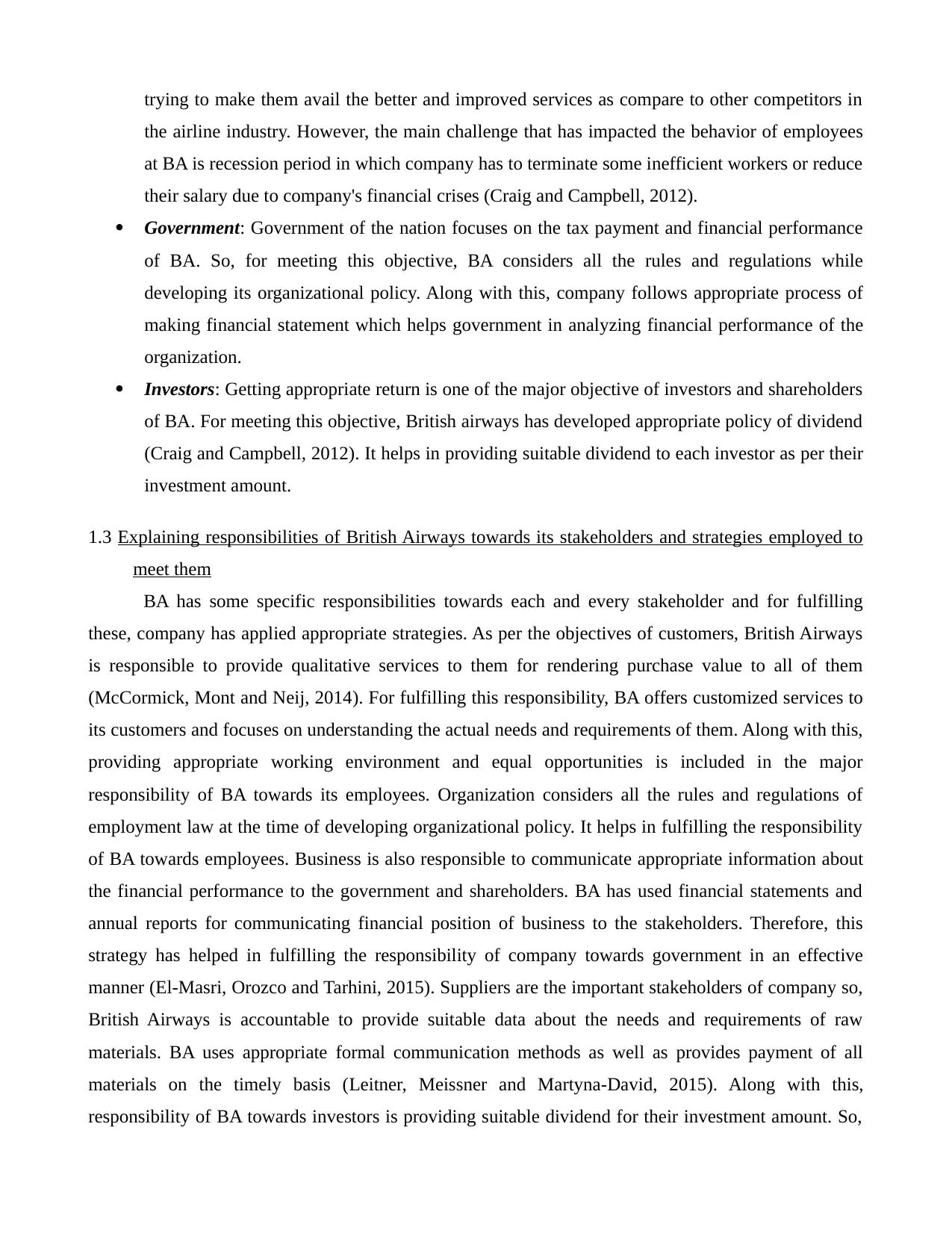
trying to make them avail the better and improved services as compare to other competitors in
the airline industry. However, the main challenge that has impacted the behavior of employees
at BA is recession period in which company has to terminate some inefficient workers or reduce
their salary due to company's financial crises (Craig and Campbell, 2012).
Government: Government of the nation focuses on the tax payment and financial performance
of BA. So, for meeting this objective, BA considers all the rules and regulations while
developing its organizational policy. Along with this, company follows appropriate process of
making financial statement which helps government in analyzing financial performance of the
organization.
Investors: Getting appropriate return is one of the major objective of investors and shareholders
of BA. For meeting this objective, British airways has developed appropriate policy of dividend
(Craig and Campbell, 2012). It helps in providing suitable dividend to each investor as per their
investment amount.
1.3 Explaining responsibilities of British Airways towards its stakeholders and strategies employed to
meet them
BA has some specific responsibilities towards each and every stakeholder and for fulfilling
these, company has applied appropriate strategies. As per the objectives of customers, British Airways
is responsible to provide qualitative services to them for rendering purchase value to all of them
(McCormick, Mont and Neij, 2014). For fulfilling this responsibility, BA offers customized services to
its customers and focuses on understanding the actual needs and requirements of them. Along with this,
providing appropriate working environment and equal opportunities is included in the major
responsibility of BA towards its employees. Organization considers all the rules and regulations of
employment law at the time of developing organizational policy. It helps in fulfilling the responsibility
of BA towards employees. Business is also responsible to communicate appropriate information about
the financial performance to the government and shareholders. BA has used financial statements and
annual reports for communicating financial position of business to the stakeholders. Therefore, this
strategy has helped in fulfilling the responsibility of company towards government in an effective
manner (El-Masri, Orozco and Tarhini, 2015). Suppliers are the important stakeholders of company so,
British Airways is accountable to provide suitable data about the needs and requirements of raw
materials. BA uses appropriate formal communication methods as well as provides payment of all
materials on the timely basis (Leitner, Meissner and Martyna-David, 2015). Along with this,
responsibility of BA towards investors is providing suitable dividend for their investment amount. So,
the airline industry. However, the main challenge that has impacted the behavior of employees
at BA is recession period in which company has to terminate some inefficient workers or reduce
their salary due to company's financial crises (Craig and Campbell, 2012).
Government: Government of the nation focuses on the tax payment and financial performance
of BA. So, for meeting this objective, BA considers all the rules and regulations while
developing its organizational policy. Along with this, company follows appropriate process of
making financial statement which helps government in analyzing financial performance of the
organization.
Investors: Getting appropriate return is one of the major objective of investors and shareholders
of BA. For meeting this objective, British airways has developed appropriate policy of dividend
(Craig and Campbell, 2012). It helps in providing suitable dividend to each investor as per their
investment amount.
1.3 Explaining responsibilities of British Airways towards its stakeholders and strategies employed to
meet them
BA has some specific responsibilities towards each and every stakeholder and for fulfilling
these, company has applied appropriate strategies. As per the objectives of customers, British Airways
is responsible to provide qualitative services to them for rendering purchase value to all of them
(McCormick, Mont and Neij, 2014). For fulfilling this responsibility, BA offers customized services to
its customers and focuses on understanding the actual needs and requirements of them. Along with this,
providing appropriate working environment and equal opportunities is included in the major
responsibility of BA towards its employees. Organization considers all the rules and regulations of
employment law at the time of developing organizational policy. It helps in fulfilling the responsibility
of BA towards employees. Business is also responsible to communicate appropriate information about
the financial performance to the government and shareholders. BA has used financial statements and
annual reports for communicating financial position of business to the stakeholders. Therefore, this
strategy has helped in fulfilling the responsibility of company towards government in an effective
manner (El-Masri, Orozco and Tarhini, 2015). Suppliers are the important stakeholders of company so,
British Airways is accountable to provide suitable data about the needs and requirements of raw
materials. BA uses appropriate formal communication methods as well as provides payment of all
materials on the timely basis (Leitner, Meissner and Martyna-David, 2015). Along with this,
responsibility of BA towards investors is providing suitable dividend for their investment amount. So,
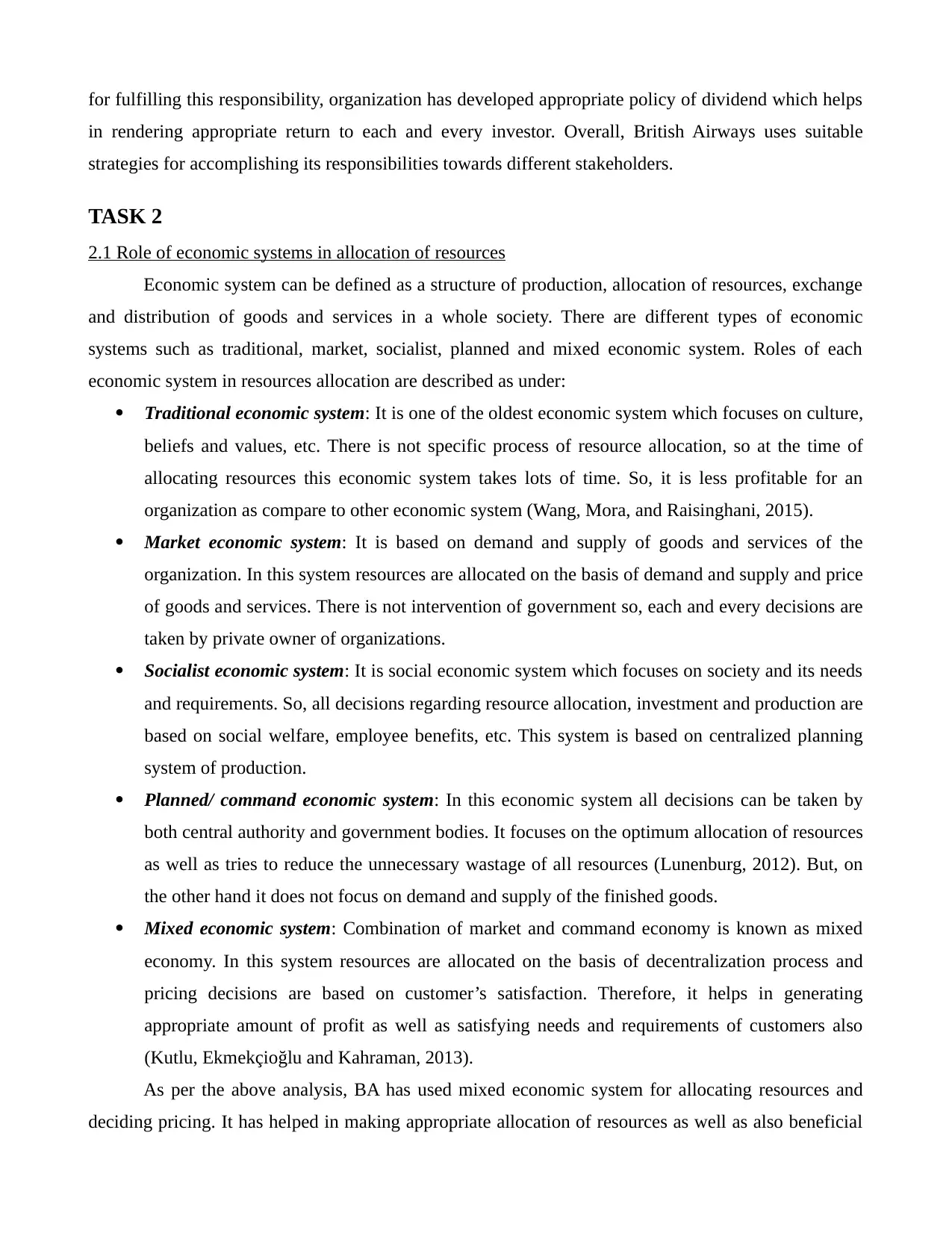
for fulfilling this responsibility, organization has developed appropriate policy of dividend which helps
in rendering appropriate return to each and every investor. Overall, British Airways uses suitable
strategies for accomplishing its responsibilities towards different stakeholders.
TASK 2
2.1 Role of economic systems in allocation of resources
Economic system can be defined as a structure of production, allocation of resources, exchange
and distribution of goods and services in a whole society. There are different types of economic
systems such as traditional, market, socialist, planned and mixed economic system. Roles of each
economic system in resources allocation are described as under:
Traditional economic system: It is one of the oldest economic system which focuses on culture,
beliefs and values, etc. There is not specific process of resource allocation, so at the time of
allocating resources this economic system takes lots of time. So, it is less profitable for an
organization as compare to other economic system (Wang, Mora, and Raisinghani, 2015).
Market economic system: It is based on demand and supply of goods and services of the
organization. In this system resources are allocated on the basis of demand and supply and price
of goods and services. There is not intervention of government so, each and every decisions are
taken by private owner of organizations.
Socialist economic system: It is social economic system which focuses on society and its needs
and requirements. So, all decisions regarding resource allocation, investment and production are
based on social welfare, employee benefits, etc. This system is based on centralized planning
system of production.
Planned/ command economic system: In this economic system all decisions can be taken by
both central authority and government bodies. It focuses on the optimum allocation of resources
as well as tries to reduce the unnecessary wastage of all resources (Lunenburg, 2012). But, on
the other hand it does not focus on demand and supply of the finished goods.
Mixed economic system: Combination of market and command economy is known as mixed
economy. In this system resources are allocated on the basis of decentralization process and
pricing decisions are based on customer’s satisfaction. Therefore, it helps in generating
appropriate amount of profit as well as satisfying needs and requirements of customers also
(Kutlu, Ekmekçioğlu and Kahraman, 2013).
As per the above analysis, BA has used mixed economic system for allocating resources and
deciding pricing. It has helped in making appropriate allocation of resources as well as also beneficial
in rendering appropriate return to each and every investor. Overall, British Airways uses suitable
strategies for accomplishing its responsibilities towards different stakeholders.
TASK 2
2.1 Role of economic systems in allocation of resources
Economic system can be defined as a structure of production, allocation of resources, exchange
and distribution of goods and services in a whole society. There are different types of economic
systems such as traditional, market, socialist, planned and mixed economic system. Roles of each
economic system in resources allocation are described as under:
Traditional economic system: It is one of the oldest economic system which focuses on culture,
beliefs and values, etc. There is not specific process of resource allocation, so at the time of
allocating resources this economic system takes lots of time. So, it is less profitable for an
organization as compare to other economic system (Wang, Mora, and Raisinghani, 2015).
Market economic system: It is based on demand and supply of goods and services of the
organization. In this system resources are allocated on the basis of demand and supply and price
of goods and services. There is not intervention of government so, each and every decisions are
taken by private owner of organizations.
Socialist economic system: It is social economic system which focuses on society and its needs
and requirements. So, all decisions regarding resource allocation, investment and production are
based on social welfare, employee benefits, etc. This system is based on centralized planning
system of production.
Planned/ command economic system: In this economic system all decisions can be taken by
both central authority and government bodies. It focuses on the optimum allocation of resources
as well as tries to reduce the unnecessary wastage of all resources (Lunenburg, 2012). But, on
the other hand it does not focus on demand and supply of the finished goods.
Mixed economic system: Combination of market and command economy is known as mixed
economy. In this system resources are allocated on the basis of decentralization process and
pricing decisions are based on customer’s satisfaction. Therefore, it helps in generating
appropriate amount of profit as well as satisfying needs and requirements of customers also
(Kutlu, Ekmekçioğlu and Kahraman, 2013).
As per the above analysis, BA has used mixed economic system for allocating resources and
deciding pricing. It has helped in making appropriate allocation of resources as well as also beneficial
⊘ This is a preview!⊘
Do you want full access?
Subscribe today to unlock all pages.

Trusted by 1+ million students worldwide
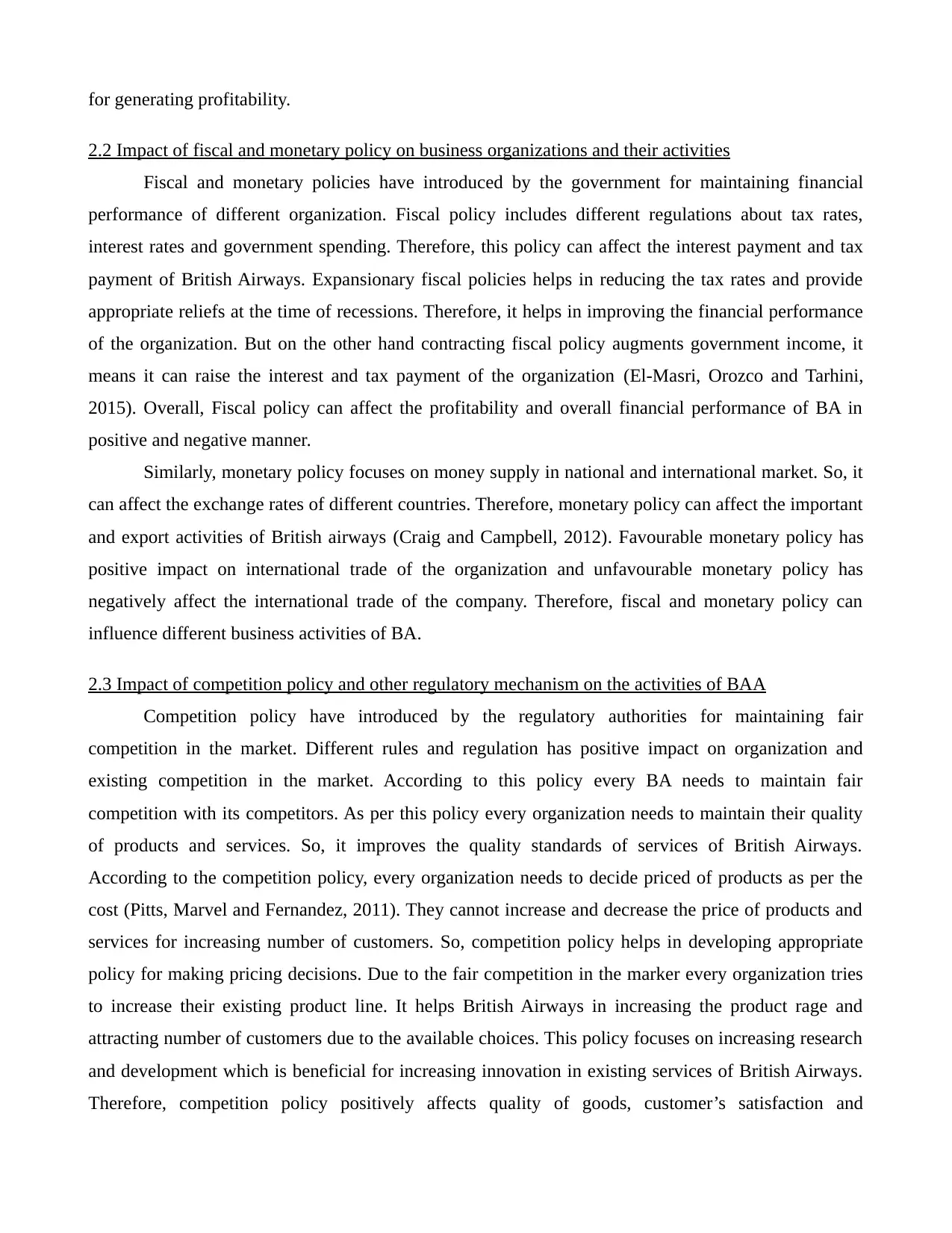
for generating profitability.
2.2 Impact of fiscal and monetary policy on business organizations and their activities
Fiscal and monetary policies have introduced by the government for maintaining financial
performance of different organization. Fiscal policy includes different regulations about tax rates,
interest rates and government spending. Therefore, this policy can affect the interest payment and tax
payment of British Airways. Expansionary fiscal policies helps in reducing the tax rates and provide
appropriate reliefs at the time of recessions. Therefore, it helps in improving the financial performance
of the organization. But on the other hand contracting fiscal policy augments government income, it
means it can raise the interest and tax payment of the organization (El-Masri, Orozco and Tarhini,
2015). Overall, Fiscal policy can affect the profitability and overall financial performance of BA in
positive and negative manner.
Similarly, monetary policy focuses on money supply in national and international market. So, it
can affect the exchange rates of different countries. Therefore, monetary policy can affect the important
and export activities of British airways (Craig and Campbell, 2012). Favourable monetary policy has
positive impact on international trade of the organization and unfavourable monetary policy has
negatively affect the international trade of the company. Therefore, fiscal and monetary policy can
influence different business activities of BA.
2.3 Impact of competition policy and other regulatory mechanism on the activities of BAA
Competition policy have introduced by the regulatory authorities for maintaining fair
competition in the market. Different rules and regulation has positive impact on organization and
existing competition in the market. According to this policy every BA needs to maintain fair
competition with its competitors. As per this policy every organization needs to maintain their quality
of products and services. So, it improves the quality standards of services of British Airways.
According to the competition policy, every organization needs to decide priced of products as per the
cost (Pitts, Marvel and Fernandez, 2011). They cannot increase and decrease the price of products and
services for increasing number of customers. So, competition policy helps in developing appropriate
policy for making pricing decisions. Due to the fair competition in the marker every organization tries
to increase their existing product line. It helps British Airways in increasing the product rage and
attracting number of customers due to the available choices. This policy focuses on increasing research
and development which is beneficial for increasing innovation in existing services of British Airways.
Therefore, competition policy positively affects quality of goods, customer’s satisfaction and
2.2 Impact of fiscal and monetary policy on business organizations and their activities
Fiscal and monetary policies have introduced by the government for maintaining financial
performance of different organization. Fiscal policy includes different regulations about tax rates,
interest rates and government spending. Therefore, this policy can affect the interest payment and tax
payment of British Airways. Expansionary fiscal policies helps in reducing the tax rates and provide
appropriate reliefs at the time of recessions. Therefore, it helps in improving the financial performance
of the organization. But on the other hand contracting fiscal policy augments government income, it
means it can raise the interest and tax payment of the organization (El-Masri, Orozco and Tarhini,
2015). Overall, Fiscal policy can affect the profitability and overall financial performance of BA in
positive and negative manner.
Similarly, monetary policy focuses on money supply in national and international market. So, it
can affect the exchange rates of different countries. Therefore, monetary policy can affect the important
and export activities of British airways (Craig and Campbell, 2012). Favourable monetary policy has
positive impact on international trade of the organization and unfavourable monetary policy has
negatively affect the international trade of the company. Therefore, fiscal and monetary policy can
influence different business activities of BA.
2.3 Impact of competition policy and other regulatory mechanism on the activities of BAA
Competition policy have introduced by the regulatory authorities for maintaining fair
competition in the market. Different rules and regulation has positive impact on organization and
existing competition in the market. According to this policy every BA needs to maintain fair
competition with its competitors. As per this policy every organization needs to maintain their quality
of products and services. So, it improves the quality standards of services of British Airways.
According to the competition policy, every organization needs to decide priced of products as per the
cost (Pitts, Marvel and Fernandez, 2011). They cannot increase and decrease the price of products and
services for increasing number of customers. So, competition policy helps in developing appropriate
policy for making pricing decisions. Due to the fair competition in the marker every organization tries
to increase their existing product line. It helps British Airways in increasing the product rage and
attracting number of customers due to the available choices. This policy focuses on increasing research
and development which is beneficial for increasing innovation in existing services of British Airways.
Therefore, competition policy positively affects quality of goods, customer’s satisfaction and
Paraphrase This Document
Need a fresh take? Get an instant paraphrase of this document with our AI Paraphraser
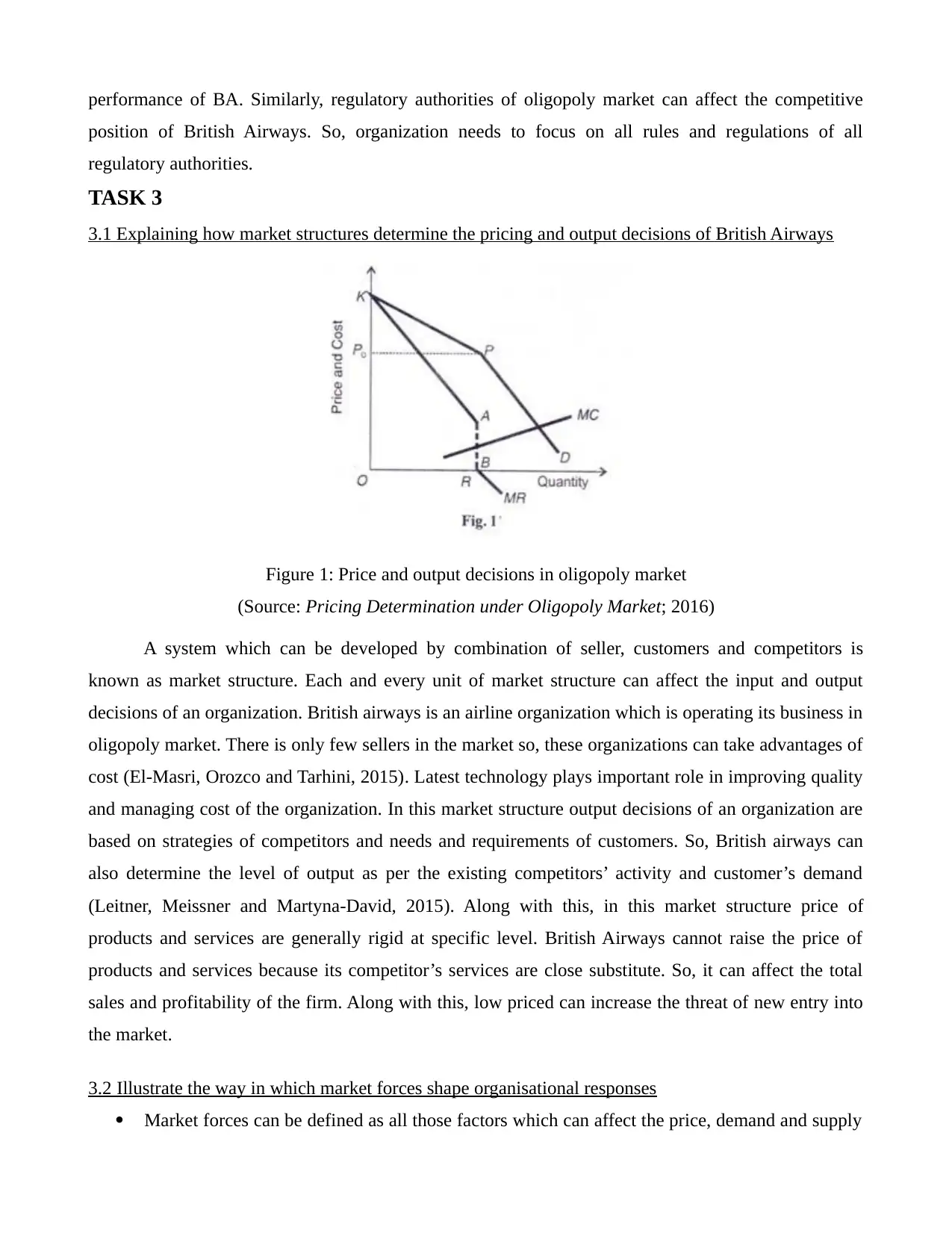
performance of BA. Similarly, regulatory authorities of oligopoly market can affect the competitive
position of British Airways. So, organization needs to focus on all rules and regulations of all
regulatory authorities.
TASK 3
3.1 Explaining how market structures determine the pricing and output decisions of British Airways
Figure 1: Price and output decisions in oligopoly market
(Source: Pricing Determination under Oligopoly Market; 2016)
A system which can be developed by combination of seller, customers and competitors is
known as market structure. Each and every unit of market structure can affect the input and output
decisions of an organization. British airways is an airline organization which is operating its business in
oligopoly market. There is only few sellers in the market so, these organizations can take advantages of
cost (El-Masri, Orozco and Tarhini, 2015). Latest technology plays important role in improving quality
and managing cost of the organization. In this market structure output decisions of an organization are
based on strategies of competitors and needs and requirements of customers. So, British airways can
also determine the level of output as per the existing competitors’ activity and customer’s demand
(Leitner, Meissner and Martyna-David, 2015). Along with this, in this market structure price of
products and services are generally rigid at specific level. British Airways cannot raise the price of
products and services because its competitor’s services are close substitute. So, it can affect the total
sales and profitability of the firm. Along with this, low priced can increase the threat of new entry into
the market.
3.2 Illustrate the way in which market forces shape organisational responses
Market forces can be defined as all those factors which can affect the price, demand and supply
position of British Airways. So, organization needs to focus on all rules and regulations of all
regulatory authorities.
TASK 3
3.1 Explaining how market structures determine the pricing and output decisions of British Airways
Figure 1: Price and output decisions in oligopoly market
(Source: Pricing Determination under Oligopoly Market; 2016)
A system which can be developed by combination of seller, customers and competitors is
known as market structure. Each and every unit of market structure can affect the input and output
decisions of an organization. British airways is an airline organization which is operating its business in
oligopoly market. There is only few sellers in the market so, these organizations can take advantages of
cost (El-Masri, Orozco and Tarhini, 2015). Latest technology plays important role in improving quality
and managing cost of the organization. In this market structure output decisions of an organization are
based on strategies of competitors and needs and requirements of customers. So, British airways can
also determine the level of output as per the existing competitors’ activity and customer’s demand
(Leitner, Meissner and Martyna-David, 2015). Along with this, in this market structure price of
products and services are generally rigid at specific level. British Airways cannot raise the price of
products and services because its competitor’s services are close substitute. So, it can affect the total
sales and profitability of the firm. Along with this, low priced can increase the threat of new entry into
the market.
3.2 Illustrate the way in which market forces shape organisational responses
Market forces can be defined as all those factors which can affect the price, demand and supply
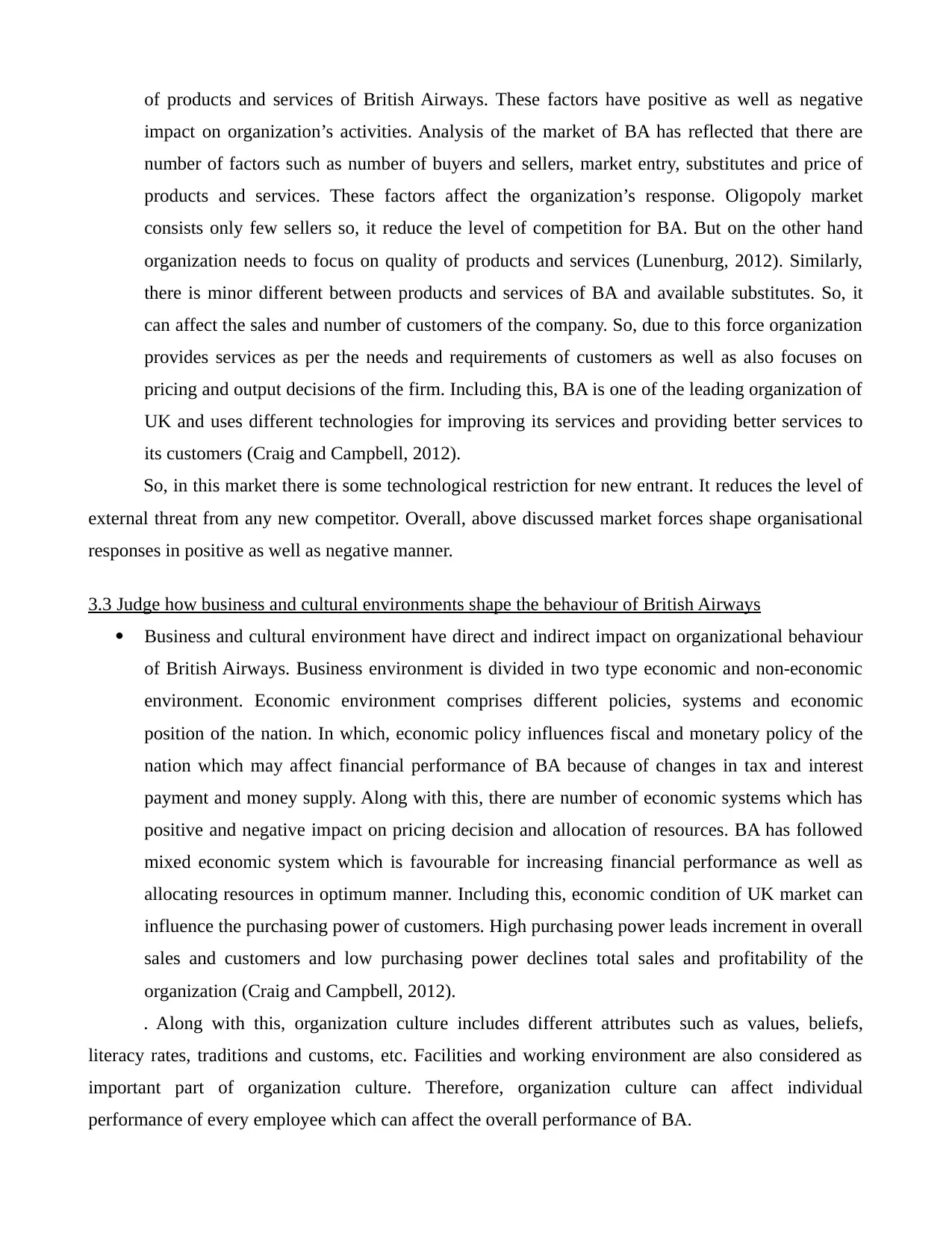
of products and services of British Airways. These factors have positive as well as negative
impact on organization’s activities. Analysis of the market of BA has reflected that there are
number of factors such as number of buyers and sellers, market entry, substitutes and price of
products and services. These factors affect the organization’s response. Oligopoly market
consists only few sellers so, it reduce the level of competition for BA. But on the other hand
organization needs to focus on quality of products and services (Lunenburg, 2012). Similarly,
there is minor different between products and services of BA and available substitutes. So, it
can affect the sales and number of customers of the company. So, due to this force organization
provides services as per the needs and requirements of customers as well as also focuses on
pricing and output decisions of the firm. Including this, BA is one of the leading organization of
UK and uses different technologies for improving its services and providing better services to
its customers (Craig and Campbell, 2012).
So, in this market there is some technological restriction for new entrant. It reduces the level of
external threat from any new competitor. Overall, above discussed market forces shape organisational
responses in positive as well as negative manner.
3.3 Judge how business and cultural environments shape the behaviour of British Airways
Business and cultural environment have direct and indirect impact on organizational behaviour
of British Airways. Business environment is divided in two type economic and non-economic
environment. Economic environment comprises different policies, systems and economic
position of the nation. In which, economic policy influences fiscal and monetary policy of the
nation which may affect financial performance of BA because of changes in tax and interest
payment and money supply. Along with this, there are number of economic systems which has
positive and negative impact on pricing decision and allocation of resources. BA has followed
mixed economic system which is favourable for increasing financial performance as well as
allocating resources in optimum manner. Including this, economic condition of UK market can
influence the purchasing power of customers. High purchasing power leads increment in overall
sales and customers and low purchasing power declines total sales and profitability of the
organization (Craig and Campbell, 2012).
. Along with this, organization culture includes different attributes such as values, beliefs,
literacy rates, traditions and customs, etc. Facilities and working environment are also considered as
important part of organization culture. Therefore, organization culture can affect individual
performance of every employee which can affect the overall performance of BA.
impact on organization’s activities. Analysis of the market of BA has reflected that there are
number of factors such as number of buyers and sellers, market entry, substitutes and price of
products and services. These factors affect the organization’s response. Oligopoly market
consists only few sellers so, it reduce the level of competition for BA. But on the other hand
organization needs to focus on quality of products and services (Lunenburg, 2012). Similarly,
there is minor different between products and services of BA and available substitutes. So, it
can affect the sales and number of customers of the company. So, due to this force organization
provides services as per the needs and requirements of customers as well as also focuses on
pricing and output decisions of the firm. Including this, BA is one of the leading organization of
UK and uses different technologies for improving its services and providing better services to
its customers (Craig and Campbell, 2012).
So, in this market there is some technological restriction for new entrant. It reduces the level of
external threat from any new competitor. Overall, above discussed market forces shape organisational
responses in positive as well as negative manner.
3.3 Judge how business and cultural environments shape the behaviour of British Airways
Business and cultural environment have direct and indirect impact on organizational behaviour
of British Airways. Business environment is divided in two type economic and non-economic
environment. Economic environment comprises different policies, systems and economic
position of the nation. In which, economic policy influences fiscal and monetary policy of the
nation which may affect financial performance of BA because of changes in tax and interest
payment and money supply. Along with this, there are number of economic systems which has
positive and negative impact on pricing decision and allocation of resources. BA has followed
mixed economic system which is favourable for increasing financial performance as well as
allocating resources in optimum manner. Including this, economic condition of UK market can
influence the purchasing power of customers. High purchasing power leads increment in overall
sales and customers and low purchasing power declines total sales and profitability of the
organization (Craig and Campbell, 2012).
. Along with this, organization culture includes different attributes such as values, beliefs,
literacy rates, traditions and customs, etc. Facilities and working environment are also considered as
important part of organization culture. Therefore, organization culture can affect individual
performance of every employee which can affect the overall performance of BA.
⊘ This is a preview!⊘
Do you want full access?
Subscribe today to unlock all pages.

Trusted by 1+ million students worldwide
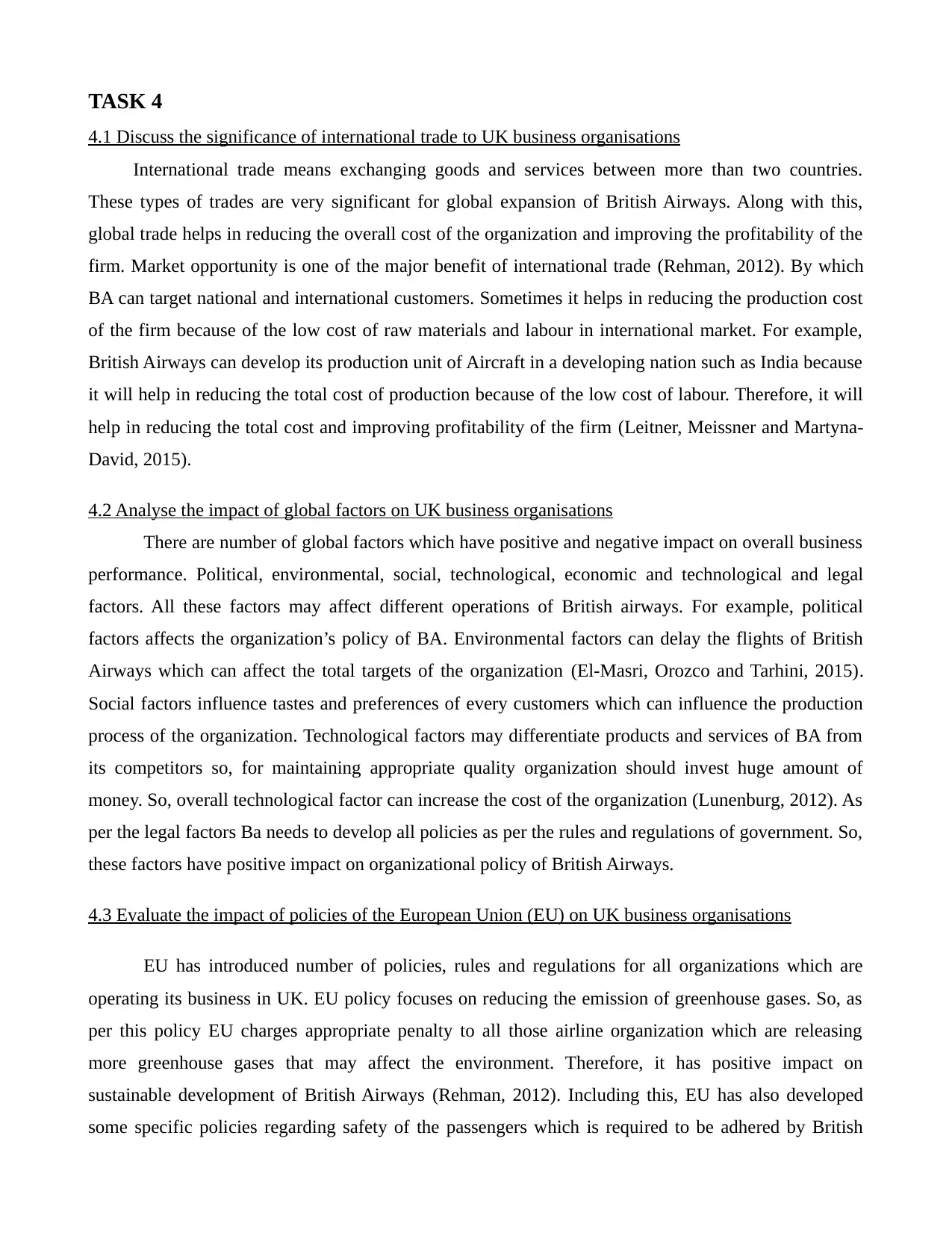
TASK 4
4.1 Discuss the significance of international trade to UK business organisations
International trade means exchanging goods and services between more than two countries.
These types of trades are very significant for global expansion of British Airways. Along with this,
global trade helps in reducing the overall cost of the organization and improving the profitability of the
firm. Market opportunity is one of the major benefit of international trade (Rehman, 2012). By which
BA can target national and international customers. Sometimes it helps in reducing the production cost
of the firm because of the low cost of raw materials and labour in international market. For example,
British Airways can develop its production unit of Aircraft in a developing nation such as India because
it will help in reducing the total cost of production because of the low cost of labour. Therefore, it will
help in reducing the total cost and improving profitability of the firm (Leitner, Meissner and Martyna-
David, 2015).
4.2 Analyse the impact of global factors on UK business organisations
There are number of global factors which have positive and negative impact on overall business
performance. Political, environmental, social, technological, economic and technological and legal
factors. All these factors may affect different operations of British airways. For example, political
factors affects the organization’s policy of BA. Environmental factors can delay the flights of British
Airways which can affect the total targets of the organization (El-Masri, Orozco and Tarhini, 2015).
Social factors influence tastes and preferences of every customers which can influence the production
process of the organization. Technological factors may differentiate products and services of BA from
its competitors so, for maintaining appropriate quality organization should invest huge amount of
money. So, overall technological factor can increase the cost of the organization (Lunenburg, 2012). As
per the legal factors Ba needs to develop all policies as per the rules and regulations of government. So,
these factors have positive impact on organizational policy of British Airways.
4.3 Evaluate the impact of policies of the European Union (EU) on UK business organisations
EU has introduced number of policies, rules and regulations for all organizations which are
operating its business in UK. EU policy focuses on reducing the emission of greenhouse gases. So, as
per this policy EU charges appropriate penalty to all those airline organization which are releasing
more greenhouse gases that may affect the environment. Therefore, it has positive impact on
sustainable development of British Airways (Rehman, 2012). Including this, EU has also developed
some specific policies regarding safety of the passengers which is required to be adhered by British
4.1 Discuss the significance of international trade to UK business organisations
International trade means exchanging goods and services between more than two countries.
These types of trades are very significant for global expansion of British Airways. Along with this,
global trade helps in reducing the overall cost of the organization and improving the profitability of the
firm. Market opportunity is one of the major benefit of international trade (Rehman, 2012). By which
BA can target national and international customers. Sometimes it helps in reducing the production cost
of the firm because of the low cost of raw materials and labour in international market. For example,
British Airways can develop its production unit of Aircraft in a developing nation such as India because
it will help in reducing the total cost of production because of the low cost of labour. Therefore, it will
help in reducing the total cost and improving profitability of the firm (Leitner, Meissner and Martyna-
David, 2015).
4.2 Analyse the impact of global factors on UK business organisations
There are number of global factors which have positive and negative impact on overall business
performance. Political, environmental, social, technological, economic and technological and legal
factors. All these factors may affect different operations of British airways. For example, political
factors affects the organization’s policy of BA. Environmental factors can delay the flights of British
Airways which can affect the total targets of the organization (El-Masri, Orozco and Tarhini, 2015).
Social factors influence tastes and preferences of every customers which can influence the production
process of the organization. Technological factors may differentiate products and services of BA from
its competitors so, for maintaining appropriate quality organization should invest huge amount of
money. So, overall technological factor can increase the cost of the organization (Lunenburg, 2012). As
per the legal factors Ba needs to develop all policies as per the rules and regulations of government. So,
these factors have positive impact on organizational policy of British Airways.
4.3 Evaluate the impact of policies of the European Union (EU) on UK business organisations
EU has introduced number of policies, rules and regulations for all organizations which are
operating its business in UK. EU policy focuses on reducing the emission of greenhouse gases. So, as
per this policy EU charges appropriate penalty to all those airline organization which are releasing
more greenhouse gases that may affect the environment. Therefore, it has positive impact on
sustainable development of British Airways (Rehman, 2012). Including this, EU has also developed
some specific policies regarding safety of the passengers which is required to be adhered by British
Paraphrase This Document
Need a fresh take? Get an instant paraphrase of this document with our AI Paraphraser
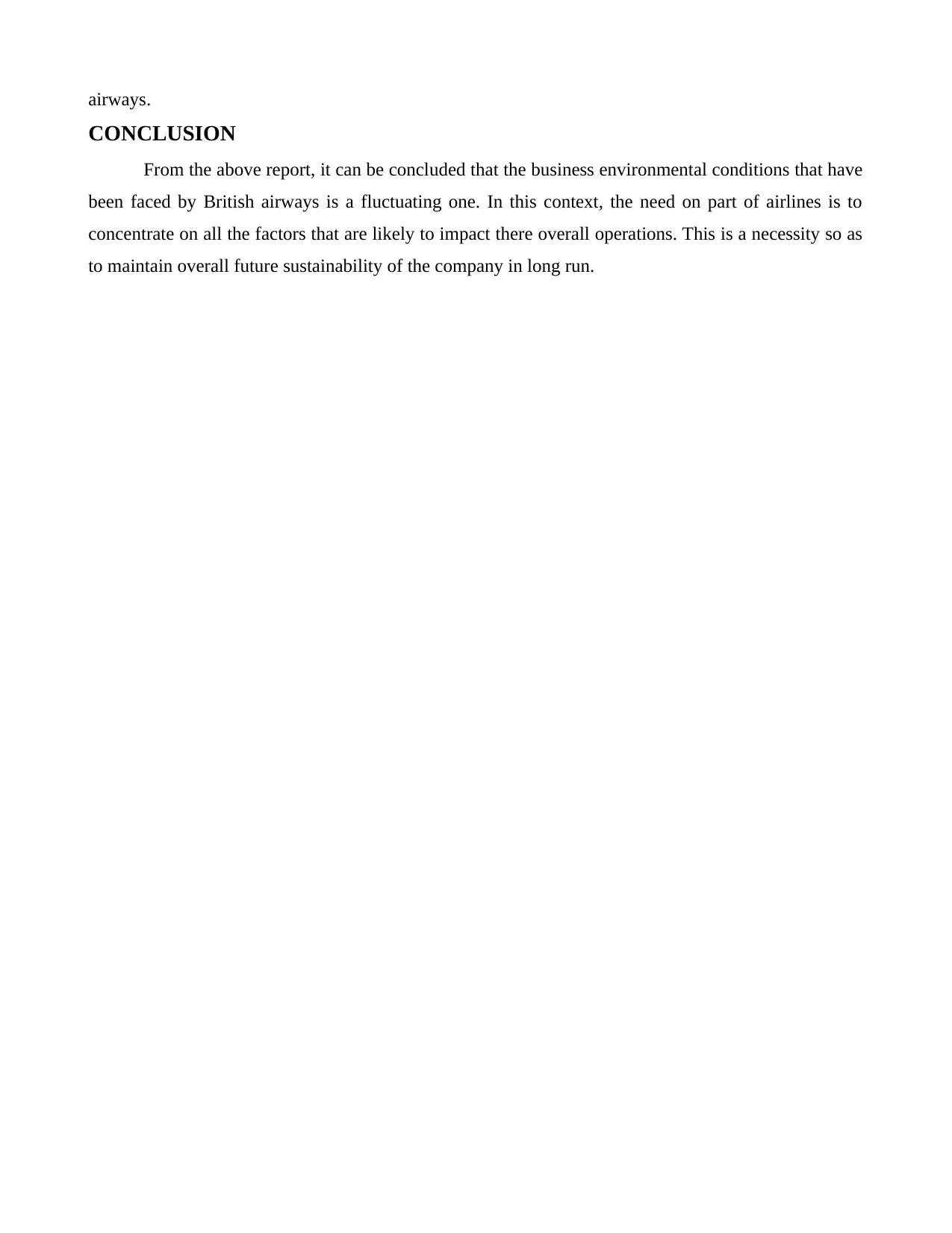
airways.
CONCLUSION
From the above report, it can be concluded that the business environmental conditions that have
been faced by British airways is a fluctuating one. In this context, the need on part of airlines is to
concentrate on all the factors that are likely to impact there overall operations. This is a necessity so as
to maintain overall future sustainability of the company in long run.
CONCLUSION
From the above report, it can be concluded that the business environmental conditions that have
been faced by British airways is a fluctuating one. In this context, the need on part of airlines is to
concentrate on all the factors that are likely to impact there overall operations. This is a necessity so as
to maintain overall future sustainability of the company in long run.
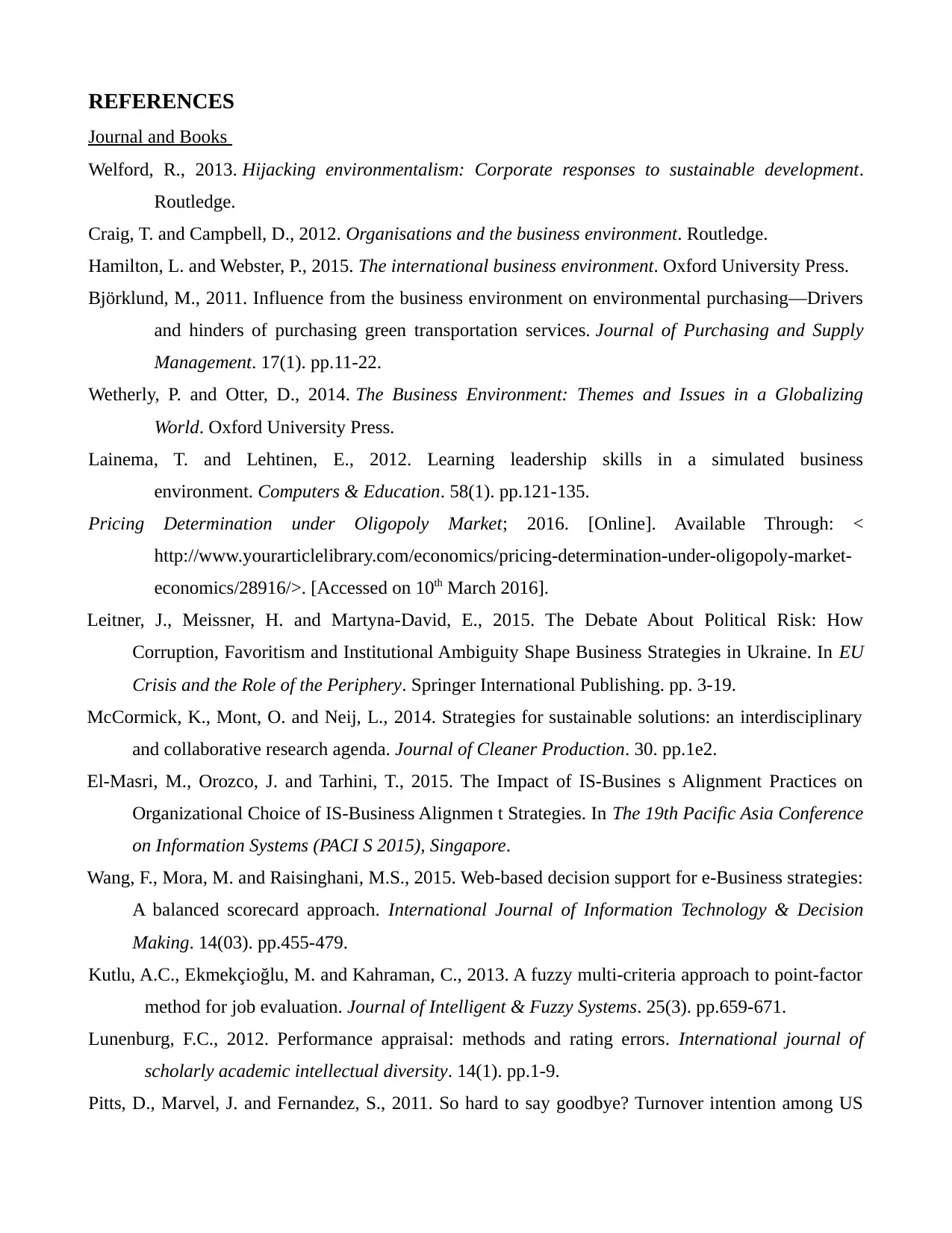
REFERENCES
Journal and Books
Welford, R., 2013. Hijacking environmentalism: Corporate responses to sustainable development.
Routledge.
Craig, T. and Campbell, D., 2012. Organisations and the business environment. Routledge.
Hamilton, L. and Webster, P., 2015. The international business environment. Oxford University Press.
Björklund, M., 2011. Influence from the business environment on environmental purchasing—Drivers
and hinders of purchasing green transportation services. Journal of Purchasing and Supply
Management. 17(1). pp.11-22.
Wetherly, P. and Otter, D., 2014. The Business Environment: Themes and Issues in a Globalizing
World. Oxford University Press.
Lainema, T. and Lehtinen, E., 2012. Learning leadership skills in a simulated business
environment. Computers & Education. 58(1). pp.121-135.
Pricing Determination under Oligopoly Market; 2016. [Online]. Available Through: <
http://www.yourarticlelibrary.com/economics/pricing-determination-under-oligopoly-market-
economics/28916/>. [Accessed on 10th March 2016].
Leitner, J., Meissner, H. and Martyna-David, E., 2015. The Debate About Political Risk: How
Corruption, Favoritism and Institutional Ambiguity Shape Business Strategies in Ukraine. In EU
Crisis and the Role of the Periphery. Springer International Publishing. pp. 3-19.
McCormick, K., Mont, O. and Neij, L., 2014. Strategies for sustainable solutions: an interdisciplinary
and collaborative research agenda. Journal of Cleaner Production. 30. pp.1e2.
El-Masri, M., Orozco, J. and Tarhini, T., 2015. The Impact of IS-Busines s Alignment Practices on
Organizational Choice of IS-Business Alignmen t Strategies. In The 19th Pacific Asia Conference
on Information Systems (PACI S 2015), Singapore.
Wang, F., Mora, M. and Raisinghani, M.S., 2015. Web-based decision support for e-Business strategies:
A balanced scorecard approach. International Journal of Information Technology & Decision
Making. 14(03). pp.455-479.
Kutlu, A.C., Ekmekçioğlu, M. and Kahraman, C., 2013. A fuzzy multi-criteria approach to point-factor
method for job evaluation. Journal of Intelligent & Fuzzy Systems. 25(3). pp.659-671.
Lunenburg, F.C., 2012. Performance appraisal: methods and rating errors. International journal of
scholarly academic intellectual diversity. 14(1). pp.1-9.
Pitts, D., Marvel, J. and Fernandez, S., 2011. So hard to say goodbye? Turnover intention among US
Journal and Books
Welford, R., 2013. Hijacking environmentalism: Corporate responses to sustainable development.
Routledge.
Craig, T. and Campbell, D., 2012. Organisations and the business environment. Routledge.
Hamilton, L. and Webster, P., 2015. The international business environment. Oxford University Press.
Björklund, M., 2011. Influence from the business environment on environmental purchasing—Drivers
and hinders of purchasing green transportation services. Journal of Purchasing and Supply
Management. 17(1). pp.11-22.
Wetherly, P. and Otter, D., 2014. The Business Environment: Themes and Issues in a Globalizing
World. Oxford University Press.
Lainema, T. and Lehtinen, E., 2012. Learning leadership skills in a simulated business
environment. Computers & Education. 58(1). pp.121-135.
Pricing Determination under Oligopoly Market; 2016. [Online]. Available Through: <
http://www.yourarticlelibrary.com/economics/pricing-determination-under-oligopoly-market-
economics/28916/>. [Accessed on 10th March 2016].
Leitner, J., Meissner, H. and Martyna-David, E., 2015. The Debate About Political Risk: How
Corruption, Favoritism and Institutional Ambiguity Shape Business Strategies in Ukraine. In EU
Crisis and the Role of the Periphery. Springer International Publishing. pp. 3-19.
McCormick, K., Mont, O. and Neij, L., 2014. Strategies for sustainable solutions: an interdisciplinary
and collaborative research agenda. Journal of Cleaner Production. 30. pp.1e2.
El-Masri, M., Orozco, J. and Tarhini, T., 2015. The Impact of IS-Busines s Alignment Practices on
Organizational Choice of IS-Business Alignmen t Strategies. In The 19th Pacific Asia Conference
on Information Systems (PACI S 2015), Singapore.
Wang, F., Mora, M. and Raisinghani, M.S., 2015. Web-based decision support for e-Business strategies:
A balanced scorecard approach. International Journal of Information Technology & Decision
Making. 14(03). pp.455-479.
Kutlu, A.C., Ekmekçioğlu, M. and Kahraman, C., 2013. A fuzzy multi-criteria approach to point-factor
method for job evaluation. Journal of Intelligent & Fuzzy Systems. 25(3). pp.659-671.
Lunenburg, F.C., 2012. Performance appraisal: methods and rating errors. International journal of
scholarly academic intellectual diversity. 14(1). pp.1-9.
Pitts, D., Marvel, J. and Fernandez, S., 2011. So hard to say goodbye? Turnover intention among US
⊘ This is a preview!⊘
Do you want full access?
Subscribe today to unlock all pages.

Trusted by 1+ million students worldwide
1 out of 13
Related Documents
Your All-in-One AI-Powered Toolkit for Academic Success.
+13062052269
info@desklib.com
Available 24*7 on WhatsApp / Email
![[object Object]](/_next/static/media/star-bottom.7253800d.svg)
Unlock your academic potential
Copyright © 2020–2025 A2Z Services. All Rights Reserved. Developed and managed by ZUCOL.





